How to Set Up the Internet Upload on Nvidia Rtx 2060 Ti
NVIDIA NVENC OBS Guide
By Gerardo Delgado Cabrera on February 26, 2019 | Guides Dissemination Streaming
ABOUT THIS GUIDE
The objective of this guide is to help you understand how to utilize the NVIDIA encoder, NVENC, in OBS. Nosotros have simplified some of the concepts to brand this accessible to a wider audience. If you lot retrieve we can improve any part of this guide or notice any problems or mistakes, delight postal service below and we will exist happy to update it.
BITRATE, RESOLUTION AND FRAMERATE
Encoding is all virtually compressing images. The smaller the size of the paradigm, the less we must compress it and the more than quality it keeps. While the same applies for framerate, a viewer can really find a drop in FPS but not so much in resolution, and then we will e'er endeavour to stream at lx FPS.
Commencement, run a speed examination to determine your upload speed (e.one thousand. Speed Test). We want to apply around 75% of your upload speed, as the game and other programs such as Discord will also fight for bandwidth.
And so, we will decide the resolution and FPS that we can use for such bitrate. Most streaming sites take recommendations (Twitch, Youtube, Facebook Gaming) on what to utilize. These are ours:
| Upload Speed | Bitrate | Resolution | Framerate |
| 3 Mbps | 2,500 | 1024x576 | 30 |
| 4 Mbps | 3,500 | 1280x720 | 30 |
| 6 Mbps | 5,000 | 1280x720 | lx |
| 8-10 Mbps | 6,000 | 1920x1080 * | threescore |
| 15+ Mbps | 12,000 (Youtube) | 1920x1080 | threescore |
| 20+ Mbps | xv,000+ (Youtube) | 2560x1440 | lx |
| 40+ Mbps | 30,000+ (Youtube) | 3840x2160 | 60 |
* Important Annotation for High Motility Content. If you are going to stream high motility scenes (i.eastward. Racing games, some Boxing Royale games, etc.) we highly recommend reducing your resolution. Loftier motion content cannot be compressed as much, and can suffer from more artifacting (encoding errors) that make your stream look "blocky". If y'all reduce the resolution, y'all reduce the data being encoded, and the resulting viewer quality is higher. For example, for Fortnite, many streamers determine to stream at 1600x900 60 FPS.
Note for New and Upcoming Streamers to Twitch. Transcoding allows a viewer to view your video on a different resolution, thus requiring a lower bandwidth. Twitch only offers guaranteed transcoding to Partners; not-partners may receive transcoding, simply information technology is not guaranteed. This is of import if your viewers are on mobile phones or their internet speed is not as fast. Yous may want to consider streaming at a lower bitrate and resolution to lower the bandwidth required to meet your aqueduct.
RECOMMENDED SETTINGS
These are our recommended settings for OBS Studio 23.0 and up. You'll want to exam and accommodate these settings by proceeding with a local recording to verify yous're happy with the results.
To access the settings, click on the Settings button on the bottom right.
VIDEO TAB SETTINGS
- Base (Sheet) Resolution: Set the resolution you normally play at. That is, your desktop resolution (if you play in borderless mode), or the game resolution yous normally enter (if you play in full screen).
- Output (Scaled) Resolution: Enter the resolution advisable for your Upload Speed and Bitrate, as we discussed in the previous department.
- Downscale Filter: This allows y'all to select a downscale filter that will provide a pocket-sized image sharpness enhancement, at the cost of some encoder workload. NVENC is very efficient and typically runs at low utilization, so we recommend using this with the Lanczos, 36 samples option for the best quality.
- FPS: Enter the FPS appropriate for your Upload Speed and Bitrate, equally nosotros discussed in the previous department.
OUTPUT TAB SETTINGS
If you want an easy, out of the box configuration, then do the following:
- Output Mode: Simple
- Streaming:
- Bitrate: Enter the Bitrate advisable for your Upload Speed, as we discussed in the previous department.
- Encoder: Select Hardware (NVENC).
- Enable Advanced Encoder Settings: Unchecked. We collaborated with OBS to fine-melody these settings, so it simply works!
- Encoder Preset: Quality. This is already the default pick. Note that information technology is only visible if y'all check Encode Avant-garde Encoder Settings.
- Recording:
- Recording Path: This is the directory where the videos will be saved. Brand sure the hard bulldoze y'all select has enough space!
- Recording Quality: Loftier Quality typically works for most users, but you can change this to Indistinguishable Quality if you have enough deejay infinite or are going to do short videos (about 60 seconds).
- Recording Format: FLV or MKV.
- Encoder: Hardware (NVENC).
OTHER SETTINGS
There are 2 other things you want to configure to ensure a polish stream:
- Windows: Brand certain yous update to Windows ten version 1903, and enable Game Way. This version includes performance enhancements for streaming, besides as an updated Game Mode uniform with streaming.
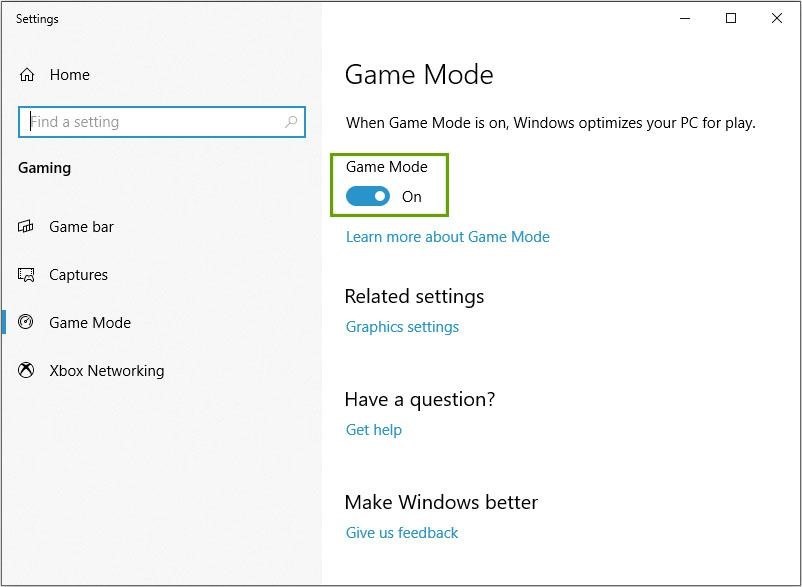
- GPU Utilization: If your GPU utilization is above 95% Windows volition start prioritizing the game over everything; this can, in some cases, make your stream lag. To solve this, OBS added an pick in OBS 24.0.three to prioritize OBS Studio over the Game. But run OBS as Admin, and your stream will be silky smooth.
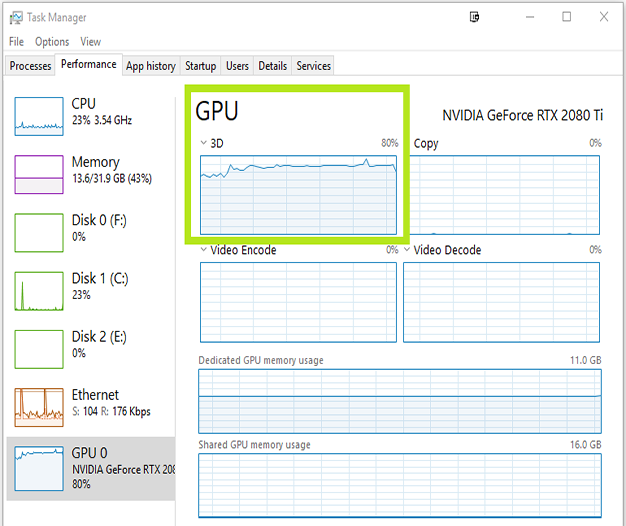
If for some reason you don't want to run OBS in Admin mode, yous can too limit your GPU usage to be below the 95% threshold. To practice this, you tin:
- Cap FPS in-game, run the game in Borderless Windowed mode, reduce game graphics or resolution, or turn V-Sync on.
- Run all assets at 1080p. To exercise that, double click on the source in OBS and under Resolution select Custom and specify a resolution equal or nether 1080p.
And at that place you have information technology! We hope this helps you amend your stream quality and reach your goals. Get out united states of america a comment if this worked for you lot or if y'all'd like us to update the guide with other info. Happy streaming!
Advanced SETTINGS
If you desire to mess around with all settings, here are our in-depth recommendations.
Streaming Settings
- Output Mode: Avant-garde. This gives you lot access to all the settings. Let's start!
- Encoder: Select NVIDIA NVENC H.264 (new).
- Enforce Streaming Service Encoder Settings: Get out this checked, this will ensure that if you enter a wrong value by error it gets corrected.
- Rate Control: Select CBR. This determines the rate at which frames are going to be encoded.
- Bitrate: Enter the bitrate appropriate for your Upload Speed, equally nosotros discussed in the previous section. Keep in mind that some platforms have a maximum bitrate (i.due east. for Twitch it's currently 6000 Kbps.).
- Keyframe Interval: Set to ii. Streaming platforms may limit what you can select hither, and well-nigh require a setting of two.
- Preset: Select Quality. Y'all tin change this to Max Quality to enable 2-pass encoding; this will provide you a minor quality increment only may cause problems in express situations in maxed out GPUs.
- Profile: Ready to High. Contour determines a grouping of settings in the H.264 Codec. It doesn't affect performance and gives admission to a ready of features that are cardinal to streaming, so this should always be prepare to High.
- Look-alee: Checked. This allows the encoder to dynamically select the number of B-Frames, between 0 and the number of B-Frames yous specify. B-frames are keen because they increase prototype quality, but they eat a lot of your available bitrate, so they reduce quality on loftier motion content. Wait-alee enables the best of both worlds. This feature is CUDA accelerated; toggle this off if your GPU utilization is loftier to ensure a smooth stream.
- Psycho Visual Tuning: Checked. This enables the Rate Baloney Optimization in the encoder, which greatly optimizes the manner you use bitrate, improving epitome quality on movement.
- GPU: 0. If yous have 2 GPUs in your organization, y'all can select which one is used to encode. This is not recommended, as NVENC is already very efficient and the little proceeds you can go from using a second card is lost by having to re-create the frame to the second GPU.
- Max B-Frames: Set to four. If yous uncheck the Look-alee option, reduce this to 2 B-Frames.
Recording Settings
- Blazon: Standard.
- Recording Path: This is the directory where the videos will exist saved. Make sure the hard drive you select has enough space!
- Recording Format: FLV; or MKV if you use multiple audio tracks.
- Sound Track: Go out it at 1 for default; you can add more sound tracks if you lot are using more than sources.
- Encoder: NVIDIA NVENC H.264 (new).
- Rate Control: We recommend CQP, although VBR will also produce skillful results.
- CQ Level (CQ): 15 (you can decrease the number to get college quality).
- Bitrate and Max Bitrate (VBR): 40,000 Bitrate; 60,000 Max bitrate. You tin increment these to 100,000 and 200,000 (respectively) for college quality.
- Keyframe Interval: 0 or two.
- Preset: Select Quality. You tin modify this to Max-Quality to enable 2-laissez passer encoding; this volition provide you a pocket-sized quality increase just may cause problems in express situations in maxed out GPUs.
- Contour: Set to High.
- Wait-alee: Checked.
- Psycho Visual Tuning: Checked.
- GPU: 0. If you have 2 GPUs in your system, you tin select which one is used to encode.
- Max B-Frames: Set to four. If y'all uncheck the Look-alee option, reduce this to two B-Frames.
ABOUT THE GEFORCE-OPTIMIZED NEW VERSION OF OBS STUDIO
We have collaborated with OBS to meliorate support for NVIDIA GeForce GPUs. The new OBS Studio, version 23.0, volition leverage the NVIDIA Video Codec SDK, which volition greatly improve performance and reduce the FPS impact of streaming and recording. We have also tweaked some of the background settings of NVENC to improve quality, especially for the RTX 20-Series GPUs.
HOW TO DEBUG Problems
Streaming can be very complicated, merely it'due south specially hard to debug. In that location are many things at play when you stream, then we are going to try to provide yous some aid on how to identify what is going wrong and how to set up it.
Components
Streaming uses the post-obit components:
- Your PC: This includes hardware and software.
- Local Internet: WiFi or cabled cyberspace + your Router.
- Your connection: To your service provider.
- The platform: Twitch, Youtube, Facebook Gaming, etc.
- Viewer's Cyberspace: Typically Wi-Fi, simply can also be 3G/4G.
- Viewer's device: continue in mind 35% of Twitch viewers are on mobile.
If something is declining, we want to kickoff identify what component may exist declining, so we don't get crazy trying to fix something that was never broken in the first place. Typically, this ways that the first test you should do is a Speed Examination to brand sure that you don't accept internet issues in your local net or your connection. 2d, brand sure the platform hasn't issued an alert that they are downward or are experiencing bug. Then based on what error you go, you start looking at one thing or another in your PC.
How to bank check what'south happening to the encode
OBS Studio includes a very useful tool: the Stats Window. To bring it upward, click on View > Stats. This window will show you Lagged and Skipped frames, Dropped frames, and Encode FPS.

This window will show you lot:
- FPS at which you are encoding.
- Latency to encode each frame.
- Missed Frames - problems with GPU.
- Skipped Frames - problems with CPU.
- Dropped Frames - problems with network.
Mutual Error Types
Stream is missing FPS. The stats window will testify missed frames. While streaming and missing frames, pull up the Task Manager > Performance, Click on GPU and bank check the 3D load and Encoder load.
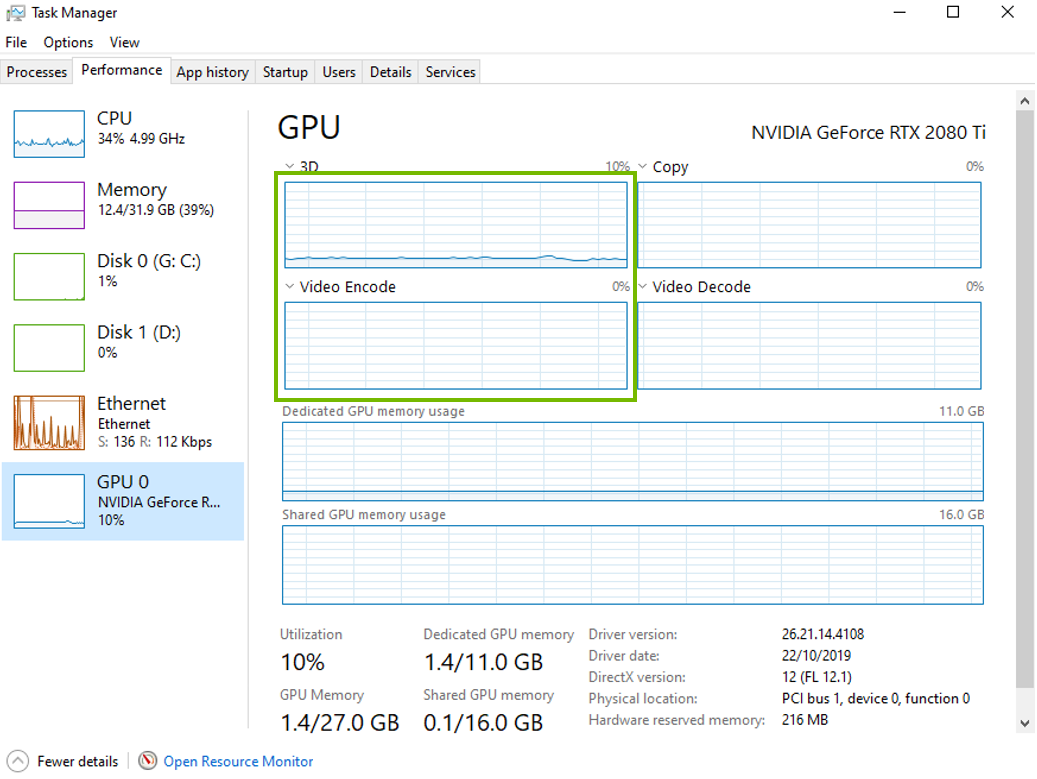
Solutions:
- If the 3D load is above 95%, especially at 1440p or 4K setups, Windows may exist prioritizing the Game over OBS. To fix this, we have a special mode inserted on OBS 24.0.3 where you lot can prioritize OBS in a higher place the Game. Simply run OBS in Game Mode.
- If the Video Encode load is maxed out, we need to lower the load. NVENC tin can practise up to 8K30, so the merely style to overload information technology is to do 2x4K60 streams. If you are encoding 4K60, brand sure that your quality setting in OBS is set to Quality, not Max Quality. Max Quality does 2 pass encoding (i.e. encodes twice), which is besides much for the encoder.
Image looks very washed out. The virtually likely issue is trying to push also much quality with not enough bitrate. Consider reducing the resolution, and frame charge per unit (if needed), and try over again. If quality improves, so suit until y'all find your sugariness spot.
Source: https://www.nvidia.com/en-us/geforce/guides/broadcasting-guide/
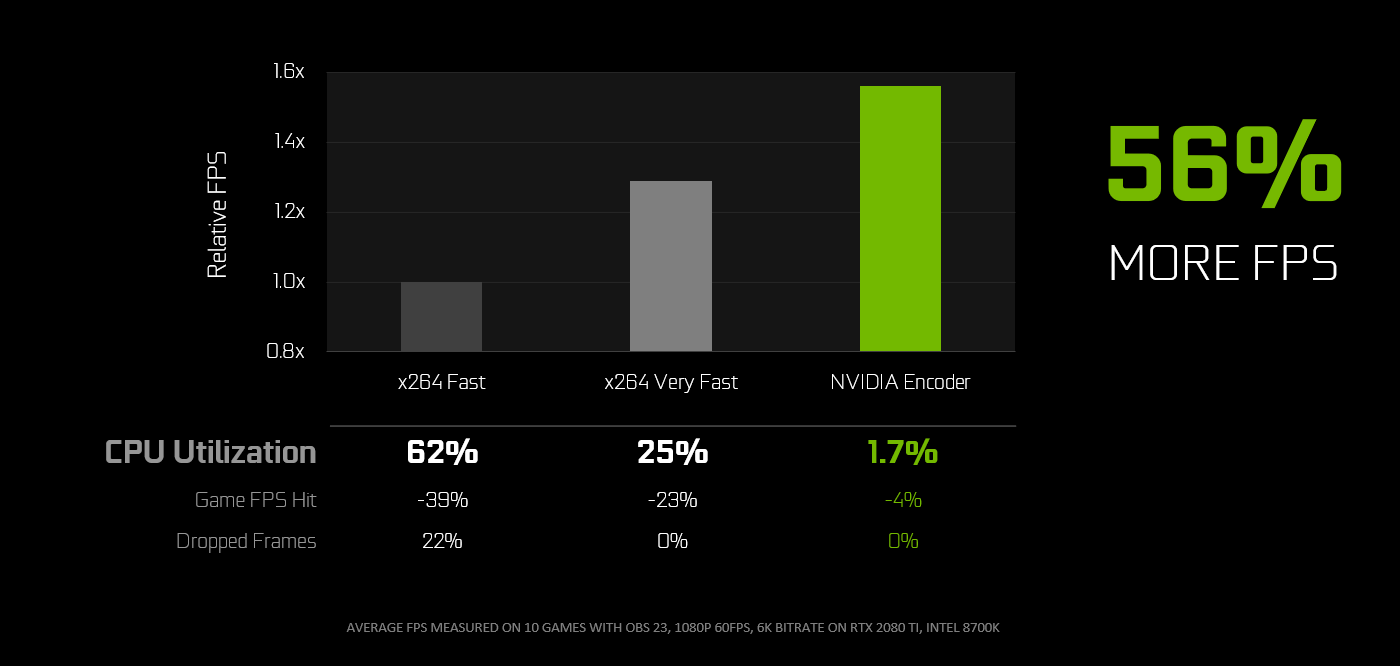
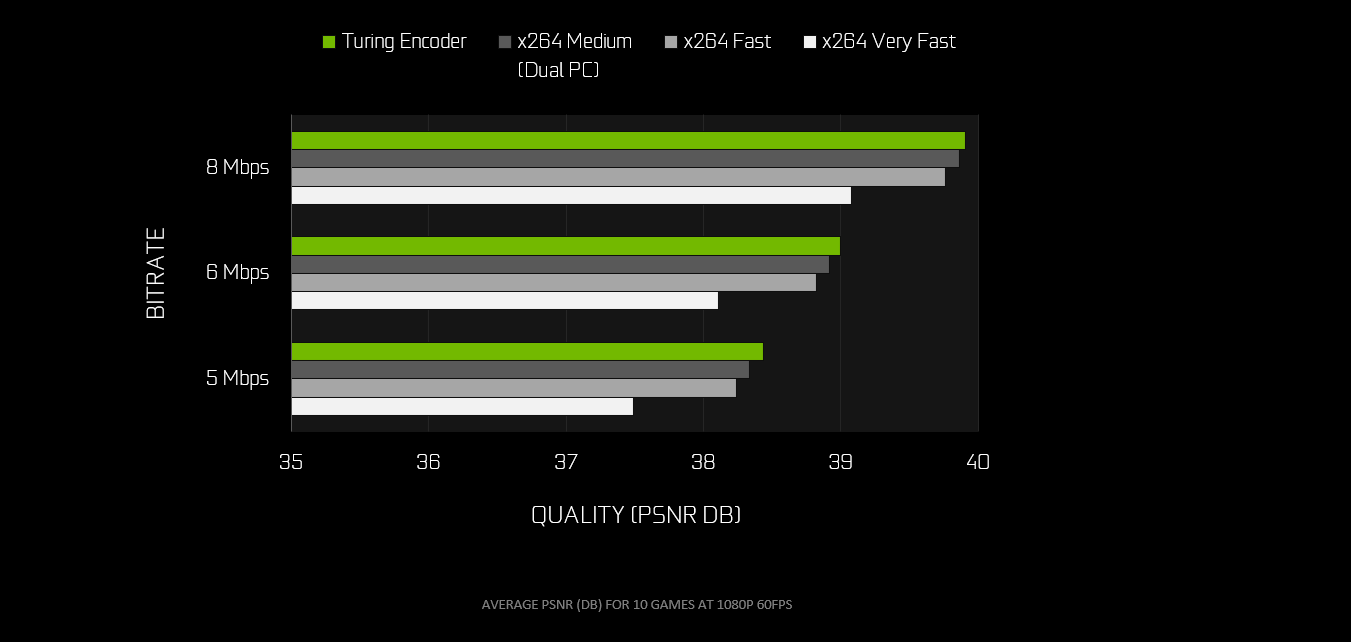
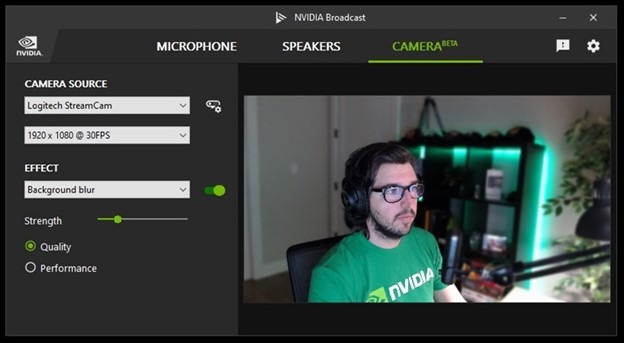
0 Response to "How to Set Up the Internet Upload on Nvidia Rtx 2060 Ti"
Enregistrer un commentaire